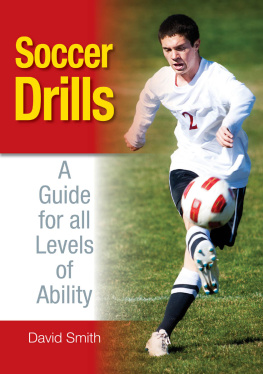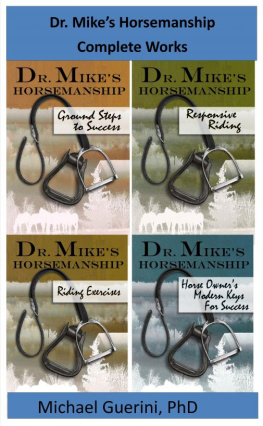101 DRILL TEAM EXERCISES
FOR HORSE & RIDER

DEBBIE SAMS

Edited by Sarah Guare and Deborah Burns
Art direction & book design by Cynthia N. McFarland
Text production by Liseann Karandisecky
Cover & interior photography by William Shepley, except for back cover & page 1 by Phelps/Hathaway Enterprises, Inc.
Arena diagrams by Chuck Galey, with additional illustrations for Exercises 8 and 16 by Bethany Caskey
Riders in chapter opener photos: Riata Ranch Cowboy Girls
Indexed by Christine R. Lindemer, Boston Road Communications
2009 by Debbie Sams
Special thanks to Heather Comerate of Drill Fever!, www.drill-fever.com, for initial photography research.
All rights reserved. No part of this book may be reproduced without written permission from the publisher, except by a reviewer who may quote brief passages or reproduce illustrations in a review with appropriate credits; nor may any part of this book be reproduced, stored in a retrieval system, or transmitted in any form or by any meanselectronic, mechanical, photocopying, recording, or otherwithout written permission from the publisher.
The information in this book is true and complete to the best of our knowledge. All recommendations are made without guarantee on the part of the author or Storey Publishing. The author and publisher disclaim any liability in connection with the use of this information. For additional information, please contact Storey Publishing, 210 MASS MoCA Way, North Adams, MA 01247.
Storey books are available for special premium and promotional uses and for customized editions. For further information, please call 1-800-793-9396.
LIBRARY OF CONGRESS CATALOGING-IN-PUBLICATION DATA
Kay Sams, Debbie.
101 drill team exercises for horse and rider / by Debbie Sams.
p. cm.
Includes index.
ISBN 978-1-60342-143-0 (paper with comb bdg. : alk. paper)
1. HorsesTraining. 2. Horsemanship. I. Title. II. Title:
One hundred one drill team exercises for horse and rider.
III. Title: One hundred and one drill team exercises for horse and rider.
SF287.K29 2009
798.2dc22
2009001485
The mission of Storey Publishing is to serve our customers by publishing practical information that encourages personal independence in harmony with the environment.
ACKNOWLEDGMENTS
Writing this book has been an exciting adventure for me! I am grateful to everyone who so graciously helped in so many ways, including Stephanie Dobiss, who proved to have a wonderful talent for critiquing drill team exercises; my husband of 25 years, Dan Sams, who encouraged me to try my hand at writing and diligently proofread the book for me; Katrina Springer, my sister, who also proofread the book; my drill team, students, and boarders, who patiently rode through many exercises and helped to tweak some of them; and the Storey Publishing staff, who were so helpful. I am blessed to have such wonderful support.
CONTENTS
INTRODUCTION
DRILL TEAM EXERCISES are fun and a good way to improve your riding skills and to enhance your horses training. They foster commitment, leadership, teamwork, and good horsemanship.
Riders of all disciplines with horses of all breed types can use the exercises in this book, which have been designed for groups of four to twelve riders. These exercises can even be used in designing individual freestyle patterns.
Components of a Good Drill
Riders know that their drills are done well when they look easy to the audience. Drills should flow smoothly and evenly from one exercise to the next.
Riders should exhibit even rating and spacing. Thread the Needle, for example, should look as if two very straight, evenly spaced lines mysteriously penetrate each other and then emerge as straight as they were. For a magical look, riders should avoid swerving, yanking, or kicking.
STARTING A DRILL TEAM |
It is essential that your drill team have: |
 Committed members who will be at every practice and work hard Committed members who will be at every practice and work hard
|
 Members who are leaders, and members who know how to follow Members who are leaders, and members who know how to follow
|
 Suitably matched horses and riders: green horses with experienced riders, and green riders with experienced horses Suitably matched horses and riders: green horses with experienced riders, and green riders with experienced horses
|
 Members with good attitudes; complainers and blamers wont fit in with those who are there to have fun and enjoy the process. If someone messes up, laugh and then work on how to do it better next time. Members with good attitudes; complainers and blamers wont fit in with those who are there to have fun and enjoy the process. If someone messes up, laugh and then work on how to do it better next time.
|
 Horses who do not bite or kick Horses who do not bite or kick
|
The bobbing heads of posting riders detract from the vision of unity. Riders should sit the trot or jog for a uniform look, unless a beginning rider has to post. The riders should practice good sitting form so that the exercises are easy on both riders and horses.
Riders should be BRATTs, reminding themselves often of the following: Bend your horse; Rate your horse; be Accurate; and emphasize Timing and Teamwork.
Keys to a Successful Practice
Riders remember the patterns best when they practice at least twice a week. You may throw together a simple drill with a couple of hours of practice and be able to present it decently right away. The more frequently you practice, however, the more polished your team will be.
The Arena
A good size for a small drill teams arena is 20 meters by 40 meters (65 feet by 130 feet). A useful rule of thumb is that all riders should fit in open formation on one long side. If the arena is so large that the team looks lost, use barrels, cones, or rails to section off an area for the drill.
Tape up dressage letters. They give reference points that indicate where the team has to go. Its easy to tape letters quickly to posts or cones. The letters used in this book are traditional dressage letters. The center-line goes the length of the arena from A to C. The letter X denotes the center of the arena.
Ground Work and Direction
Walk through the drill on the ground to learn new moves or to refresh the riders memory before the mounted practice. This is a good time to go over adjustments to improve the visual or technical aspects of the drill. On the ground, its easy to stop, back up, or reposition partway through an exercise.
An unmounted drillmaster is crucial. She is the teams eye on the ground. Riders are directed through the pattern by the drillmaster, who must have a view of the team as a whole.
At difficult spots, break down your steps and do the exercise several times until everyone feels comfortable performing it. The drillmaster should remember to solicit feedback from team members, who will often have great ideas for improving the drill.









 Committed members who will be at every practice and work hard
Committed members who will be at every practice and work hard